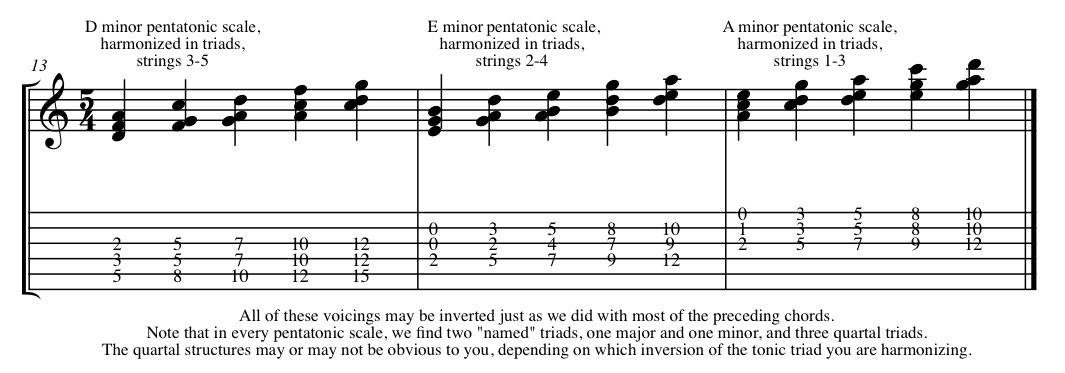Comping: So What?
(scroll down for video)
(scroll down for video)
Okay, so you’re
at a jam and they want to play “So What”. Everybody knows that one,
right? A-A-B-A form, yeah, yada yada, 8-bar sections, A sections in D
dorian, B section in Eb dorian, bass player’s got the melody... and
you’re going to play the Famous “So What” chords as a response to the
melody. “Ba-dum-ba-dum-ba-dum-de DUMMMM...(chord, chord)”.
All well and
good... until the soloing starts. Then you realize that 16 bars is a
long time to spend on D minor. What to do? If all you have in your bag
o’ tricks is the Famous “So What” Chord and the Dm7 voicing the Doobie
Brothers used and a six-string barre chord at the 10th fret, you just
might be in for a long night. Lucky you; I’ve got some suggestions to
get your personal voicing collection jump-started.
Let’s begin with
the Famous “So What” Chord. It’s a nifty mixture of perfect fourths
with a third on top. All the notes are in the D Dorian scale. What if
we took that voicing and just walked it through the Dorian scale? We
could keep it on the same group of strings, start on the lowest
possible note and walk it up the scale for an octave or so. Each note
on each string would just move up to the next available note in the
scale. While we’re at it, let’s also do it with the lowest voice
removed – sometimes four-note voicings are more useful than five-note
voicings.
That would look like this:

Some of those
sounds you’ll like; some you may not like. But they’re all possible in
the D Dorian scale and could be used for comping once you get ‘em under
your fingers and in your ears. [Don't forget:
Eb Dorian is only a half-step away. Everything we're doing here for D
Dorian can be used one fret up for the Ebm 'B' section of "So What".]
Now how about
looking at voicings made up entirely of fourths? If we start walking
fourths around in the Dorian scale, we soon discover that not all
fourths are perfect fourths – some of the fourths in that scale are
augmented fourths (tritones). That’s okay; I never met an interval I
didn’t like. Let’s do three-note quartal (fourth-based) voicings in D
Dorian. Then, just as we can do with “normal” triads, we’ll invert
them, putting each note in the chord on the bottom. Then we will wind
up with three-note voicings that contain a fourth (perfect or
augmented) and a second (major or minor). And again, it’ll all be stuff
we could use for comping in D Dorian:

We could also do
four-note voicings the same way. I did them on two different string
groups to show you how that can be done. Then I did a set of inversions
to get you started:

Next, we could
take another very common guitar voicing that’s often used to suggest
Dm6/9 or G13, among other chords. Then we could subject it to the same
treatment, moving it through the Dorian scale. These voicings might be
very tough to invert; some would be unfingerable (unless your name is
Peter Mazza – if you haven’t heard him play, go listen and come back
after you pick your jaw up off the floor!). But the point of all this
tomfoolery is to expose ourselves to new sounds. While playing around
with inversions, I came up with a couple of nice ones employing open
strings, so my fingers remained unbroken. Here are the results of the
experiment:

Last but
certainly not least, there’s pentatonic harmony. If you’ve been keeping
up with my web and video lessons, you should know that there are three
minor pentatonic scales that are consonant with D minor/ D Dorian: D
minor, E minor and A minor. So let’s harmonize all three of those
pentatonic scales starting with their tonic triads in root position.
We’ll get a nice combination of “normal” triads and quartal triads. If
you start with the tonic triads in root position, you get inverted
quartal triads. Starting with a first-inversion tonic triad gives you
stacks of fourths for your quartal triads... but you’re going to do the
other ones on your own now that I’ve shown you how, aren’t you? I would
feel SOOOOO guilty if I robbed you of the thrill of discovery.


In this video, I actually use some of all this stuff while comping a couple of choruses of "So What". I also use some things we haven't discussed, such as inverted pedal point: keeping the highest note in a voicing static while I move the bottom voices around chromatically. (This happens around 12:57 in the video.) There are a few places in which I use rootless triadic "normal" voicings that imply moving from Dm7 to G7, which are both chords from the D Dorian scale. Sometimes, there are chromatic "approach" chords – I'm sneaking up on the chord I really want to play from a fret above or below. And I decided to end with a quartal voicing from the D melodic minor scale, just for a bit of ear-tweakage at the end.
It should also
be mentioned that you can perform this process on any chord from any
scale! My students learn to do this with major, minor (especially
melodic minor) and pentatonic scales, among others. It’s a lot of work,
but it’s musically rewarding!